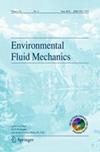顺流板构成的冠层对明渠湍流的影响
IF 2.1
3区 工程技术
Q4 ENVIRONMENTAL SCIENCES
引用次数: 0
摘要
摘要:本文研究了在粗床明渠中放置的由顺流取向薄板交错排列而成的高多孔冠层的流动。这种斑块的几何形状与由钝体制成的斑块形成对比,后者几乎只在文献中使用。采用粒子图像测速法测量斑块上游、内部和下游的流量。冠层斑块显著降低了来流的湍流程度,尤其是湍流剪应力,降低了85%。速度谱分析表明,湍流动能的减小发生在所有长度尺度上。然而,在斑块的入口处,从最小尺度到水面尺度的能量增加。这表明了一种谱捷径机制,即来流的大尺度结构被板块群分解,而不是通过能量级联衰减。增加的小尺度湍流能量随后通过斑块消散。本文章由计算机程序翻译,如有差异,请以英文原文为准。
Effect of a canopy patch made of streamwise-oriented plates on turbulence in an open-channel flow
Abstract The paper examines the flow through a highly porous canopy patch made of streamwise-oriented thin plates arranged in a staggered configuration and placed in a rough-bed open channel. This patch geometry contrasts with the patches made of bluff bodies, which are nearly exclusively used in the literature. Particle Image Velocimetry was used to measure the flow upstream, within and downstream of the patch. The canopy patch has the effect of drastically reducing the turbulence level of the incoming flow, especially the turbulence shear stress, which is reduced by 85%. Spectral analysis of the velocity shows that the reduction in turbulent kinetic energy occurs at all length scales. Yet, at the entrance of the patch, the energy from the smallest scales up to the scale of the water surface increases. This suggests a spectral shortcut mechanism by which the large-scale structures of the incoming flow are disintegrated by the group of plates instead of decaying through the energy cascade. The increased small-scale turbulent energy then dissipates through the patch.
求助全文
通过发布文献求助,成功后即可免费获取论文全文。
去求助
来源期刊

Environmental Fluid Mechanics
环境科学-海洋学
CiteScore
4.50
自引率
9.10%
发文量
75
审稿时长
>36 weeks
期刊介绍:
Environmental Fluid Mechanics is devoted to the publication of basic and applied studies broadly relating to natural fluid systems, particularly as agents for the transport and dispersion of environmental contamination. Understanding transport and dispersion processes in natural fluid flows, from the microscale to the planetary scale, serves as the basis for the development of models aimed at simulations, predictions, and ultimately sustainable environmental management. Within this scope, the subject areas are diverse and may originate from a variety of scientific and engineering disciplines: civil, mechanical and environmental engineering, meteorology, hydrology, hydraulics, limnology, and oceanography.
The editors welcome reviews and original articles treating the atmosphere (on all spatial scales), surface water (wetlands, rivers, lakes, estuaries and oceans), and laboratory simulations of natural flows (thermals, plumes, jets, etc.). In addition, the journal is a medium for the publication of interdisciplinary studies on the interactions between natural fluid systems and their boundaries (ex. air-water surface exchanges, bottom sedimentation and resuspension, and exchanges between surface and subsurface waters) as well as interactions between fluids and their contents (ex. chemical and biological loads). Articles reporting observational, experimental, modeling and theoretical investigations are all appropriate.
 求助内容:
求助内容: 应助结果提醒方式:
应助结果提醒方式:


